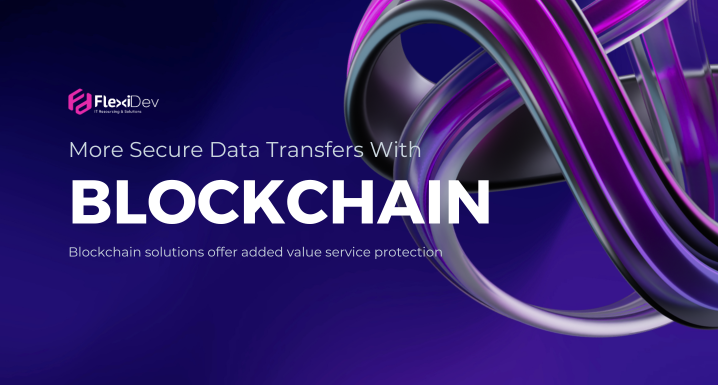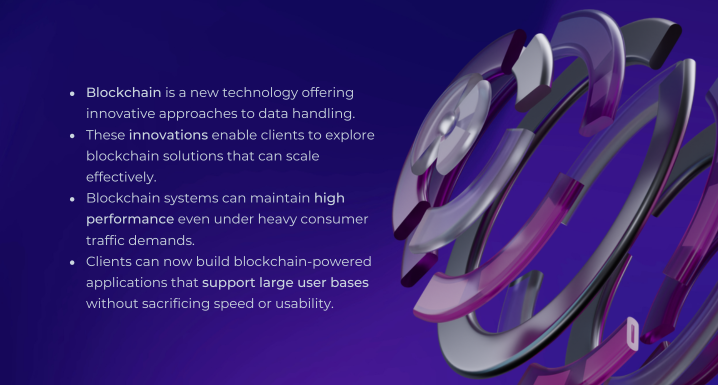
Blockchain solutions offer added value service protection
FlexiDev software engineers specialise in the most current web service technologies while, as standard, also continually furthering horizons by trialling and embracing new emerging technologies. Please find as follows our team’s findings from experience with cutting-edge uses of blockchain for secure transfers, and how this benefits businesses. Blockchain today offers software clients an increasingly powerful foundation for building secure, efficient, and transparent systems.
What is blockchain?
Traditionally associated with digitalised currencies like Bitcoin, blockchain’s core operational dynamic revolves around a decentralised storage of data. This can translate as more responsive and reliable performance for your service. With blockchain in place, retrieval of data is often faster because there are multiple storage locations for the same packet of data, and the blockchain mechanism will access the nearest available data centre to maintain rapid performance. Compare this to most servers where there is only one data point and you are therefore at times facing delays resulting from capacity overload or related issues at that site-specific data point. Blockchain is also more secure because each storage centre is set up to allow access solely to a user who must have not only the correct password and credentials, but also a demonstrated access to all the other data centres simultaneously. This last part significantly differentiates a blockchain solution, and is why blockchain has become sought-after to underpin financial transaction models.
A Ledger Technology
Blockchain maintains the link to each of it’s identical replicated data centres, as described above, through the use of ledgers. These record transactions across multiple systems to ensure security, transparency, and immutability, and only the ‘true user’ will have the correct and complete ledger record of transactions. It’s comparable to how your bank will ask for your mother’s maiden name or your favourite colour to verify identity, but on a larger and more complex scale. Each block in a chain contains a number of recorded transactions, and once a block is completed, it is added at the same time to each data point’s records in a linear, chronological order. In other words, to access protected data through blockchain relies on ‘consensus’. This consensus is when the blockchain mechanism reaches agreement among participants in a distributed network of many data centres, so that any transaction made can be verified. Notably, the consensus process has evolved with adaptations such as layer-2 blockchain that reduces the burden of data processing and system loads by bundling data records together.
Blockchain is a new technology and innovations in data handling are allowing clients to explore blockchain solutions that have the capacity to scale and reach the highest performance levels even when responding to heavy consumer traffic system demands. These innovations make it feasible for clients to build blockchain-powered applications that can power large user base infrastructure without sacrificing speed or usability.

Real-World Blockchain Use: Supply Chains
For clients offering supply chain or logistics management software, blockchain offers unmatched traceability and trust.
Case in point: Walmart’s blockchain-based tracking system enables real-time visibility from farm to shelf, allowing users to track and trace food products at each stage in production and delivery. This improves consumer confidence and facilitates rapid responses to consumer queries. Additionally, smart contracts further streamline financial processes in logistics – automating payments once goods are verified, reducing manual errors, delays, or disputes. For software clients in manufacturing and logistics, as well as in many other areas, blockchain can be a powerful enabler for efficiency, compliance, and brand trust.
______________________________________________________________________________________________________________
Looking Forward: Where Blockchain Is Headed
Blockchain is quickly moving into mainstream enterprise use, particularly in:
- Healthcare: for secure, patient-controlled medical records.
- Education: for tamper-proof credentialing and skill validation.
- Government: for identity verification and transparent service delivery.
This is still an evolving space and we would caution clients to keep informed of regulatory policy updates. Clients should partner with developers that understand the compliance landscape and who can build legally sound architectures to evolve with local protocols.
Final Word
At FlexiDev, we help software clients exploit new cutting-edge technology, be it AI or blockchain, as well as providing more traditional requirements-driven software solutions to deliver your business priorities. We investigate the practicality for implementation for your products, and offer a costed delivery plan. What’s unique about our service is you can engage our development team on-demand for as long as you need. Onboard a tech-appropriate FlexiDev engineer to upgrade your technology, and when you need to scale up development, get the same resource back again. Work with FlexiDev to explore where your tech stack should be heading, and how to get you there. Benefit from our team’s extensive experience and some technically-sound insights today. Reach out here [email protected]. Let’s talk.


